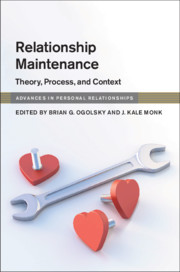Book contents
- Relationship Maintenance
- Advances in Personal Relationships
- Relationship Maintenance
- Copyright page
- Contents
- Tables
- Figures
- Contributors
- Part I Introduction
- Part II Theories of Relationship Maintenance
- 2 Interdependence Perspectives on Relationship Maintenance
- 3 An Evolutionary, Life History Theory Perspective on Relationship Maintenance
- 4 Relationship Maintenance from an Attachment Perspective
- 5 Uncertainty Perspectives on Relationship Maintenance
- 6 The Self-Expansion Model and Relationship Maintenance
- Part III Processes of Relationship Maintenance
- Part IV The Social Context of Relationship Maintenance
- Part V Conclusion
- Index
- References
6 - The Self-Expansion Model and Relationship Maintenance
from Part II - Theories of Relationship Maintenance
Published online by Cambridge University Press: 02 December 2019
- Relationship Maintenance
- Advances in Personal Relationships
- Relationship Maintenance
- Copyright page
- Contents
- Tables
- Figures
- Contributors
- Part I Introduction
- Part II Theories of Relationship Maintenance
- 2 Interdependence Perspectives on Relationship Maintenance
- 3 An Evolutionary, Life History Theory Perspective on Relationship Maintenance
- 4 Relationship Maintenance from an Attachment Perspective
- 5 Uncertainty Perspectives on Relationship Maintenance
- 6 The Self-Expansion Model and Relationship Maintenance
- Part III Processes of Relationship Maintenance
- Part IV The Social Context of Relationship Maintenance
- Part V Conclusion
- Index
- References
Summary
In this chapter, we discuss romantic relationship maintenance in the context of self-expansion. Overall, we review the self-expansion model and its accompanying empirical literature over the past 30 years, and consider some implications and future directions. Specifically, we begin by conceptualizing relationship maintenance, describing the self-expansion model (including both of its key principles: motivation to expand one's abilities to accomplish goals and including close others in the self), and covering some of the foundational work conducted with couples (e.g., self–other overlap and relational benefits of shared exciting activities). We then review research showing that relationship maintenance and self-expansion are positively related, and discuss potential mechanisms and theoretical underpinnings. We next explore more recent research on individual self-expansion and its implications for the maintenance of close relationships. Throughout the chapter, we provide illustrative examples of how self-expansion is associated with relationship characteristics, behaviors, maintenance, and outcomes. These examples will hopefully allow readers to better understand the concepts, theories, and empirical findings, and also allow utilization of this knowledge in real-life applications. Finally, we end with a summary and discussion of future directions for self-expansion and relationship researchers.
Keywords
- Type
- Chapter
- Information
- Relationship MaintenanceTheory, Process, and Context, pp. 86 - 106Publisher: Cambridge University PressPrint publication year: 2019
References
- 3
- Cited by

